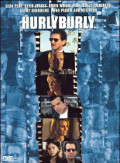
Directed by
Anthony Drazan
126 minutes
Rated MA
Reviewed by
Bernard Hemingway

Hurlyburly
Hurlyburly is based on a play by David Rabe that must have been quite a hit to make it this far but on the big screen director Anthony Drazan’s rendition (Rabe also did the screenplay) loses the impact of its intense dialogue, dissipated by the visual distractions of its all star cast and the realism afforded by the probing camera.
Playing like an even more sordid version of David Mamet’s classic portrayal of male moral turpitude, Glengarry Glen Ross (in which Kevin Spacey also starred), Hurlyburly is set in the outer circle of Tinsel Town. Sean Penn plays Eddie, a casting director who shares a house in the Hollywood Hills with his business partner, Mickey (Spacey). Eddie is in love with Darlene (Robin Wright Penn), but believes that Mickey, who is estranged from his wife, has taken her away from him. Eddie’s coke-fueled paranoia isn’t helped by regular visits from his best friend, Phil Chazz Palminteri, a bully with anger issues whose wife has thrown him out. The setting is rounded out by the presence of Artie (Garry Shandling), a shallow hanger-on who bring them Donna (Paquin), a hippie chick who trades sex for board and lodging. Eddie tries to pacify the overwrought Phil by giving him a session with exotic dancer turned call-girl, Bonnie (Meg Ryan doing her level best to destroy her girl-next-door image) but this only serves to fuel Phil's insecurities.
Although there are some laughs to be had from Penn’s scenery-chewing performance as the boozed-up, coked-out paranoiac, notably in a couple of scenes in which firstly Eddie takes Mickey to task for stealing his girl, secondly when he upbraids Darlene for not distinguishing between two different restaurants seeing her refusal to do so as indicative of her attitude towards men, for the most part, Hurlyburly is a portrayal of blokiness at its most pathetically reprehensible. And frankly who wants to spend time in such company? Whilst there is a good deal of accuracy to what we see, the film only remains a depiction and does not achieve any dramatic integrity of its own with the characters coming across as types rather than actual individuals (the hyperbolic dialogue only adds to this impression).
Hurlyburly may have worked on stage where the proscenium arch would have abstracted the tightly-wound dialogue and the performances and given them a life of their own but this screen transposition comes across as so much gratuitous celebrity gutter-crawling.
Want something different?





